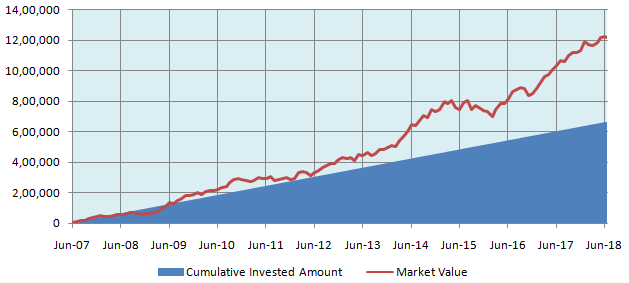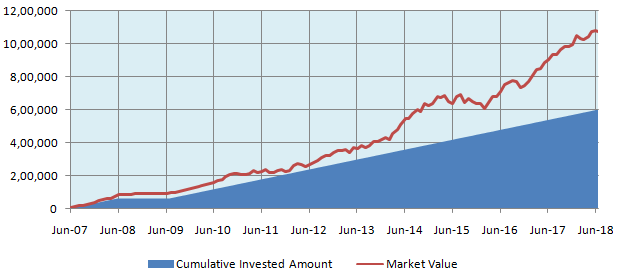Why you should continue with your SIPs even in volatile or lower markets

Legendary investor, Warren Buffett has often suggested that discipline is one of the most important attributes of successful investors. While investing behavior of most investors is influenced by greed and fear, successful investors do not allow greed and fear to override discipline. Discipline versus greed and fear distinguishes investors from speculators. Speculators make their investment decisions based on how they expect the market to trend in the near term. Investors on the other hand, make investment decisions based on their risk appetite and financial goals.
Shift in investor attitude
Historically, investment behavior or attitude of retail investors in India was largely speculative in nature. Investors increased their investments in equity in bull markets and exited out of equity in bear markets. However, over the past few years we saw a shift in investor attitude towards volatility.
As per AMFI data, in 2015, when we saw a sharp correction in the market, net inflows to equity mutual funds increased on year on year basis. The stock market has been fairly volatile this year too, though we have not yet seen a deep correction so far. Keeping with the trend seen in 2015, net inflows to equity mutual funds year to date in 2018, have increased on a year on year basis. This shows a shift in investor behavior from speculative to long term goal based investing. This is a testimony to increasing investor maturity and is very encouraging development for the investment ecosystem in our country.
Disciplined investing through SIP
One of the main contributing factors to this change in investor behavior is the rising popularity of Systematic Investment Plans (SIP) in our country. SIP takes speculation out of the equation in investing because in SIP, there is no price target for investing. You are investing at different price levels through SIP investment. Since stock markets are intrinsically volatile in nature, you will be investing both at high prices and low prices – this is known as Rupee Cost Averaging.
Every rupee invested by you will earn returns in the long term and the longer you remain invested, you can earn higher returns. Since you can start SIP with small amounts of monthly savings, you can start investing early. Remember, every SIP installment will help you earn good returns in the future and returns earned on each of your installments will in turn earn returns (profits themselves). Return on return or profit on profit is known as the power of compounding. The power of compounding in SIP is high because most of your SIP installments will be remain invested for a long time earning high returns for you.
The most important attribute of SIP is disciplined investing. You do not need to worry about market levels or having a large corpus to put in at the right level. By investing from your regular monthly savings through ECS from your bank, SIPs puts your financial planning on auto pilot. Over a period of time, discipline becomes a good habit – your discretionary spending will be in control and as your income increases over time, you will be able to save and invest more for your financial goals.
SIPs in volatile and bear markets
Warren Buffett famously said once that, “only when the tide goes out do you discover who is swimming naked”. What he is implying that, everything looks hunky dory in bull market and money can be made fairly easily. However it is in the bear market, which is inevitable, that tests how good an investor you are. Money made in 2 - 3 years of a bull market in speculative investments can be lost in a few months of a bear market – this is what Buffett means when he says, “you discover who is swimming naked”. Bear markets are unpredictable – you will not be able to guess when it will strike and how much will it fall.
Trying to time the market is a futile endeavor. Let us understand why. Firstly, you can never be sure of the market trend direction unless there is a significant one way movement, by which time the price damage has already been done - if you panic and sell, you will be selling at considerably below the highs. After you sell (redeem) you will be waiting for the market bottom – bottom is even more difficult to predict because in a bear market multiple bottoms are made. So you will wait for a confirmation that a bottom has been. What is this confirmation - basically you want to see solid evidence of a recovery. This means a longer wait. Recovery from bear market has historically been furious – we have seen a number of times that the market recovers a lot of ground from bottoms in just a few trading session. However, you cannot be sure, if this is sustainable, so you want to see more evidence. As the market bounces back, entry becomes increasingly difficult and investors have to wait longer. Finally, investors usually end up re-investing at much higher levels and there is big opportunity loss.
SIP in good equity mutual funds will ensure that you are never swimming naked no matter how strong the tide is. In fact, bear markets are greatly advantageous for disciplined investors in SIP because rupee cost averaging in a bear market will greatly reduce your overall average acquisition cost and in the long term, you can get excellent returns. Volatility is stressful for investors because no one wants to see their hard earned money going down in value. However, if you understand the fundamental principle of rupee cost averaging and futility of trying to time the market, then volatility is highly advantageous for SIP investors.
Opportunity loss of stopping your SIP in bear market
SIP was introduced in India nearly 20 years back, but it is only recently that investors are starting to realize how SIP is advantageous in volatile and falling markets. In the past bear markets, we saw investors stopping their SIPs and redeeming their investments, waiting for the correction to end before restarting again. In the following example, we will see the quantum of opportunity loss suffered by such investors.
Two investors Sumit and Sunil started SIP in mid June 2007. Purely for the purpose of illustration, let us assume that their monthly SIP amount was Rs 5,000 and they both invested in the Nifty. Sumit has continued his monthly SIP till date. Let us see how much corpus he has accumulated.

Source: National Stock Exchange
The above is only for illustration purpose. Please note that past performance may or may not sustain in future.
Sumit accumulated a corpus of around Rs 12.1 lakhs with a cumulative investment of around Rs 6.65 lakhs.
Sunil on the other hand, decided to stop his SIP and redeem, when the market fell nearly 25% in 2008 fearing that the market may fall further – his fear was justified because the Nifty fell more than 50% in 2008. He stopped his investment on June 1, 2008. He put the redemption proceeds in a 2 year FD at 9% interest rate (the 1 year FD was available at 8% interest rate, but Sunil did not want to lose the higher interest in case the market volatility persisted for a long time) and waited for the market to recover.
The market started recovering from March 2009 onwards but the sentiments were so badly bruised that Sunil needed more time see gain confidence in the evidence of solid recovery. By Aug 2009, the market recovered Aug 2008 levels, but it still way below January 2008 highs. However, since the price had recovered to the level at which Sunil sold, he resumed his SIP and continued it till date. By June 2010, when his FD term expired, Sunil had gained more confidence in equity market, so he invested the maturity proceeds of the FD in lump sum in Nifty.
Let us now see how much corpus Sunil accumulated.

Source: National Stock Exchange
The above is only for illustration purpose. Please note that past performance may or may not sustain in future.
Sunil accumulated a corpus of Rs 10.8 lakhs (Rs 1.4 lakhs less than Sumit) with a cumulative investment of around Rs 6.0 lakhs (Rs 50,000 less than Sumit), even though he put in much more effort than Sumit tracking market levels and shifting asset allocations.
Conclusion
Sunil is not the only example of investors who were worse off by stopping their SIPs in volatile markets. In fact, based on our experience, many investors fared much worse than Sunil because he was able re-enter in 1-2 years, whereas many investors waited for 4 – 5 years till 2014 bull market rally began and prices were much higher. Our advice to investors is to understand the difference between risk and volatility. Risk is the possibility of making a loss. You will make a loss, only if you sell; if you remain invested, chances of making a loss are very low, because the market will eventually recover and set new highs. Instead of worrying about volatility and trying to time the market, both of which are uncontrollable and unpredictable, you should remain focused on your financial goals and remain disciplined in investing through systematic investment plans.
Mutual Fund Investments are subject to market risk, read all scheme related documents carefully.
#Wise With Edelweiss – An Investor Education Initiative by Edelweiss Mutual Fund.
EAML is amongst the fastest growing asset management companies, being an asset management subsidiary of Edelweiss Financial Services Ltd., one of Indias leading financial services group since last 21 years with a proven track record of quality and innovation. Edelweiss AML is present across 11 locations across the country. EAML offers a suite of differentiated asset management products and the unique knowledge proposition focusing on building a strong connect with Distributors and customers. At Edelweiss AMC, the aim is to come up with truly innovative ideas that doesnt exist today and bridge the gap between what investors want and what the industry has to offer.
Quick Links
Contact Us
- Toll Free : 1800 425 0090
- Non Toll Free : +91-40-23001181
- EMFHelp@edelweissfin.com
- distributor.amc@edelweissfin.com
POST A QUERY





